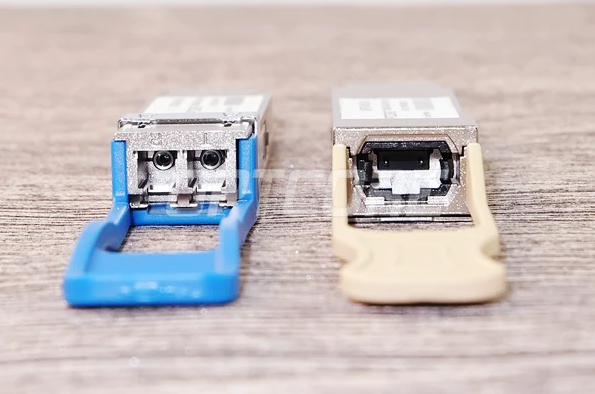

 Knowledge Base +
Knowledge Base +  2023.11.28
2023.11.28The terms "40G QSFP" and "100G QSFP" refer to different types of QSFP (Quad Small Form-Factor Pluggable) transceiver modules used in networking and data communication. These modules are designed to provide high-speed data transmission over optical fibers. Here are the key differences between 40G QSFP and 100G QSFP:

Data Rate:
40G QSFP: This module supports a data rate of 40 gigabits per second (Gbps). It is commonly used for 40 Gigabit Ethernet (40GbE) connections.
100G QSFP: This module supports a higher data rate of 100 gigabits per second (Gbps). It is used for 100 Gigabit Ethernet (100GbE) connections.
Use Cases:
40G QSFP: Primarily used for applications requiring a 40Gbps data rate, such as in certain data center connections.
100G QSFP: Used for applications requiring a 100Gbps data rate, providing higher bandwidth for more demanding network environments.
Connectivity:
Both 40G QSFP and 100G QSFP modules can support various types of optical connectors, such as LC duplex connectors for fiber optic connections.
Fiber Type:
Both modules can be used with different types of optical fibers, including single-mode fiber (SMF) for longer-distance connections and multimode fiber (MMF) for shorter-distance connections.
Form Factor:
Both 40G QSFP and 100G QSFP modules have the same form factor, which is the QSFP form factor. QSFP modules are compact and designed to save space on networking equipment.
Compatibility:
While 40G QSFP and 100G QSFP modules operate at different data rates, they may be used in the same types of networking equipment, depending on the specific requirements of the network.
What are the Pros of using a 100G QSFP28 transceiver?
Regarding data center connectivity, there are few comparisons between 40G QSFP+ and 100G QSFP28 transceivers. The QSFP28 has a bandwidth of 100Gbps, which is 2.5 times greater than the first’s 40Gbps bandwidth. Another benefit of using the 100G QSFP28 transceiver is that it costs less per bit than the 40G QSFP+. Therefore, it’s a better choice for data center networks with high bandwidth and port density.
What are the Cons of using a 100G QSFP28 transceiver?
One downside of using the 100G QSFP28 transceiver is that it’s not as widely used as the 40G QSFP+. There may be fewer vendors with this type of transceiver, and if no vendors are available, then data center engineers will have to source a new transceiver. Additionally, because the 100G QSFP28 is a unique technology, it might not be compatible with legacy devices or networks. The QSFP28 transceiver also takes higher pricing than the 40G QSFP+, so this may not be a budget-friendly option for some data center operators.
What are the Pros of using a 40G QSFP+ transceiver?
Since QSFP+ transceiver is offered before 100G QSFP28 transceiver, it can be assumed that there are some Pros to using QSFP+ over 100G QSFP28. First, the 40G QSFP+ transceiver is widely supported by vendors, so data center engineers will have a broader range of options when it comes to choosing a transceiver. Second, 40G QSFP+ is an older technology than the 100G QSFP28 so it will be more compatible with legacy devices and networks. Third, the unit price is likely lower because the 40G QSFP+ transceiver offers lower bandwidth than 100G QSFP28. This makes it a more affordable option for data center networks but not as much port density.
What are the Cons of using a 40G QSFP+ transceiver?
The 40G QSFP+ transceiver has a smaller bandwidth density than the 100G QSFP28 so it may be insufficient for some data center network needs. Additionally, because the 40G QSFP+ transceiver is older technology, there are likely to be more compatibility issues with legacy devices and networks. Lastly, the per-bit cost of a 40G QSFP+ transceiver is likely higher than that of 100G QSFP28.
Is QSFP+ the same as QSFP28?The form factor is the same; but for the data rate, the 40G QSFP+ and 100G QSFP28 are different transceiver types. The 40G QSFP+ is an older technology that was released before the 100G QSFP28.
What are the critical differences between QSFP+ and QSFP28 transceivers?
The main differences between these transceivers are the data rate and distance range. QSFP+ support 10Gbps per lane and provide 4x10Gbps, while QSFP28 transceivers support 25Gbps per lane and provide 4x25Gbps datarate. The transmit distance and power requirements of QSFP+ transceivers also differ from those of QSFP28 transceivers.
QSFP+ vs. QSFP28, Who will be the winner?
There is no definitive answer as to which transceiver type will be the winner, as they both have advantages and disadvantages. However, based on the critical differences between these transceivers, it can be assumed that QSFP28 will be more prevalent in future data center networks.
Subscribe to the newsletter
for all the latest updates.
2-5# Building, Tongfuyu Industrial Zone, Aiqun Road, Shiyan Street, Baoan District, Shenzhen. China
